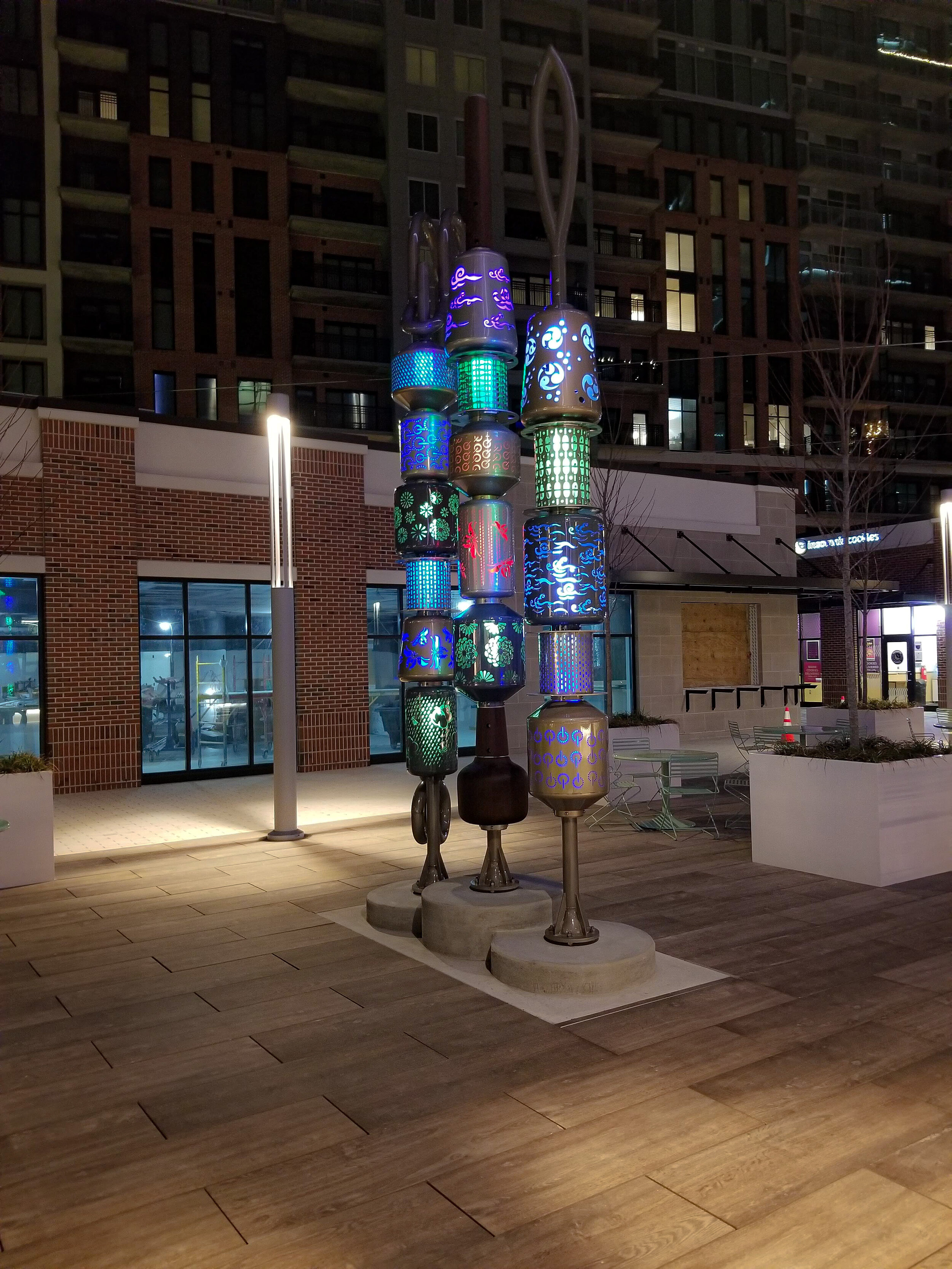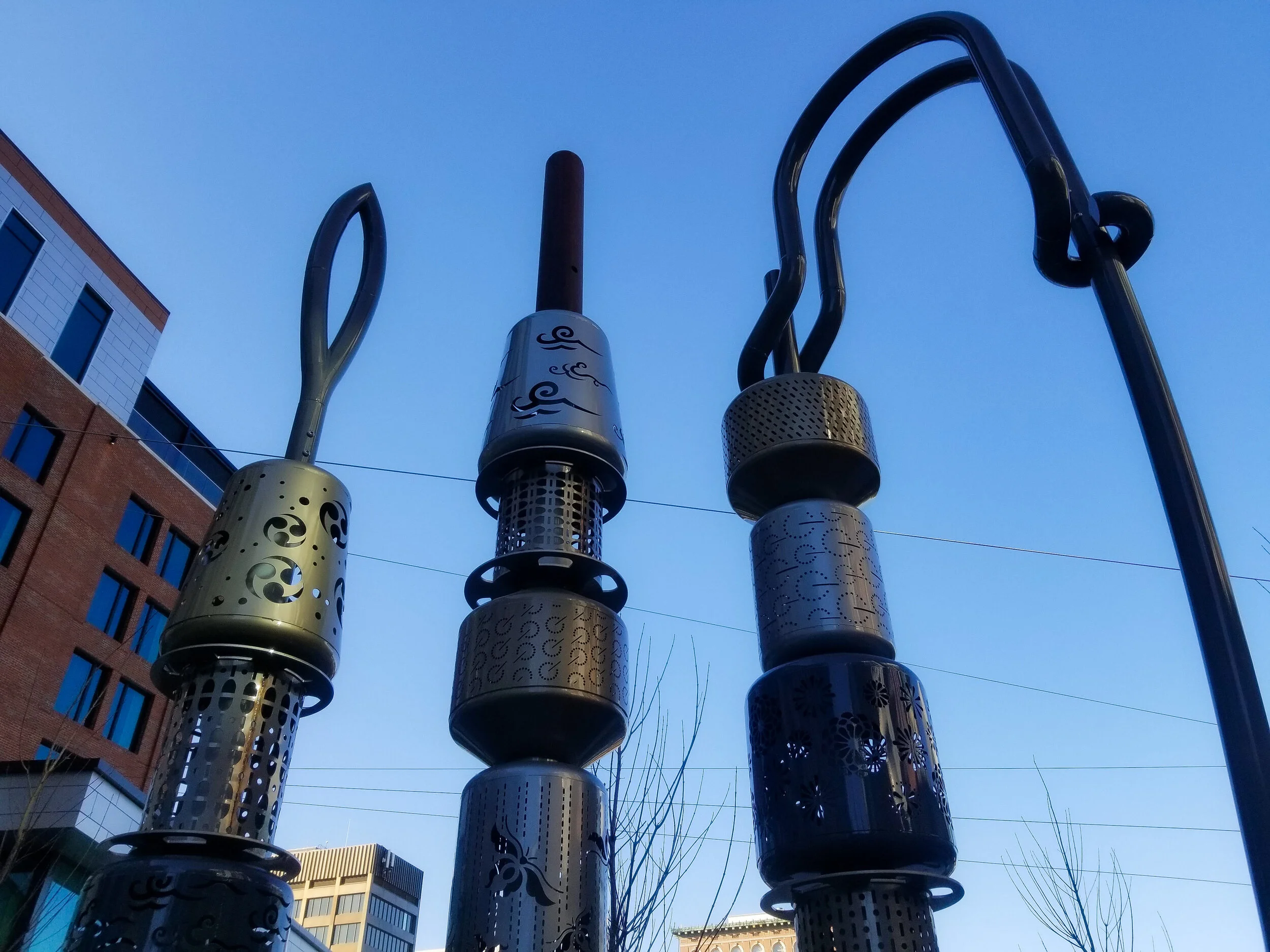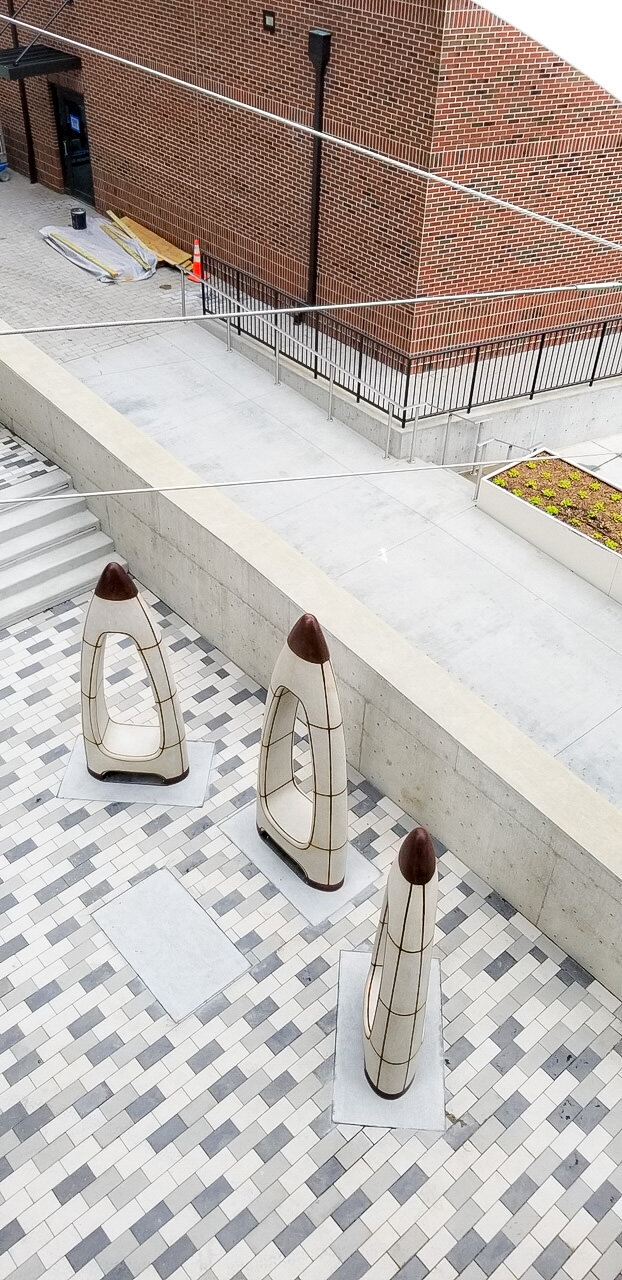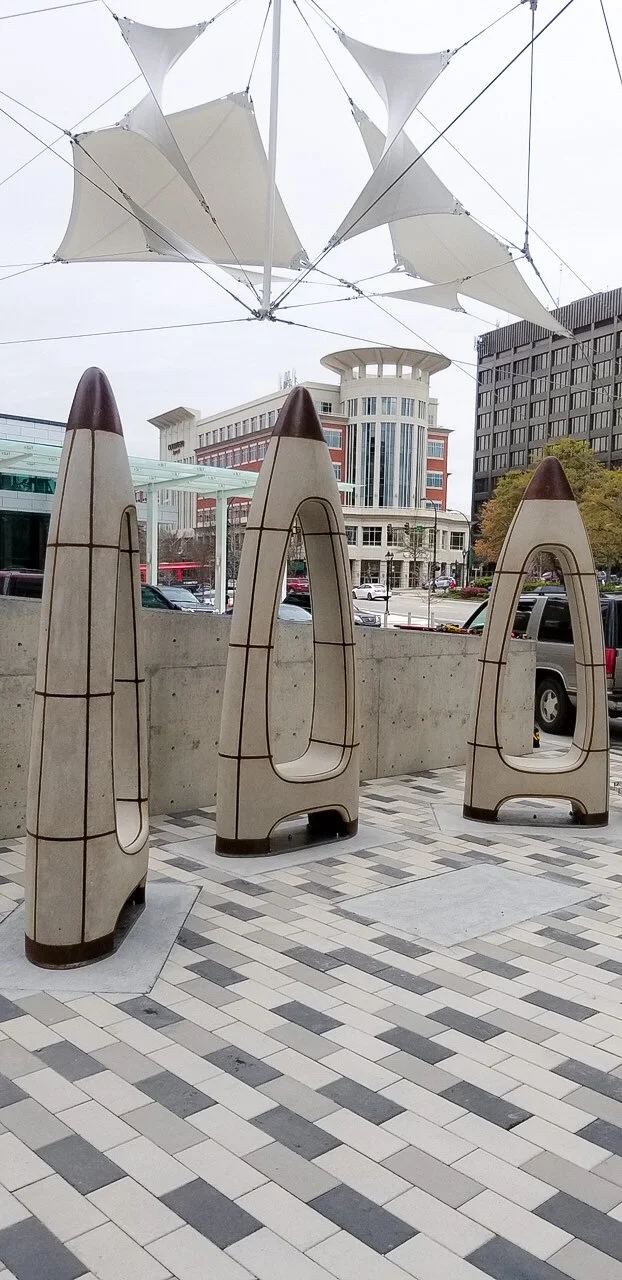Common Thread - Greenville, SC
Common Thread
Laser Cut Stainless Steel, Cast Concrete, Cast Aluminum, Wood, LED Lighting, Interactive Motion, and Sound
Camperdown Plaza - Greenville, SC
2021
Greenville’s rich textile history is the inspiration for Common Thread, the multimedia public art installation for Camperdown Plaza. Reflecting iconic shapes, designs, and patterns from the textile industry, the art is dynamic and playful with sound, light, and color. Incorporating wood, cement, and steel with programmed led lighting and sound, the sculptures weave the story of the legacy and importance of the textile industry throughout the plaza. By reimagining and oversizing the tools and equipment vital to the operation of Greenville’s textile mills, Common Thread encourages a relationship between the audience and their inter-connected natural environment. Common Thread celebrates shared history, honoring the invaluable contributions made by honoring the textile workers and their families to Greenville’s economic, industrial, and cultural development.
Common Thread celebrates the heritage and history of the founders of modern-day Greenville. Technological innovation, natural resources, and labor paved the way for the “Textile Crescent” and remain the key ingredients for sustaining communities all across America today.
Greenville’s textile industry created a dynamic mix of people. Since the 1800s, people have been moving into Greenville from all over the world; originally from Scotland, Ireland, and England. Later from Germany, Japan, Switzerland, Italy, Greece, China, Lebanon, the Philippines, Mexico, and Central and South America. It is how these resources are allocated that determines the outcome of the overall health, wellness, and economic viability of our community’s long-term. These textile settlers brought with them the seeds of cultural and economic diversity and growth. Over the last 150 years Greenville’s diversity has enabled the community to be stronger together; by bringing new language and skills, new ways of thinking, innovative ideas, and creative solutions for continuous future growth – and, of course – great food!
Greenville, South Carolina has a rich history in the textile industry dating back to the late 1800s. Referred to as the "Catalyst of the Industrial Revolution," textile manufacturing helped to transform South Carolina’s upstate and became central to the economic development of the city. Greenville's "textile crescent” included 19 textile mills attracting more than 40,000 workers to weaving, spinning, and doffing jobs (by 1960, with one-third of area residents employed in the industry). The textile plants, their jobs, and machines, the surrounding community of homes, churches, schools, and athletic facilities were a way of life for the mill workers and their families for generations. With the expansion of textile mills and railroads and the daily migration of newcomers, Greenville laid the foundation for the industrial and commercial center it became.
Three distinct groupings of public art weave Greenville’s textile story throughout the plaza sharing our rich history in light, sound, and interactivity. Each art component has a powerful visual presence during the day with compelling scales, distinct art patterns, and vibrant polished or painted finishes. At night, the space is activated with pattern and color encouraging the public to explore the exterior, as well as meander through the courtyard space as light visually converges and dynamically filters the surrounding place with subtly shifting colors and patterns in light.
Textile Totems -
Safety Pin, Needle, and Wooden Bobbin
17’H x 24” D - Laser Cut Stainless Steel, Wood with Programmed LED Lighting
A seventeen-foot-tall stainless steel needle, safety pin, and wooden bobbin anchor the center courtyard of the Camperdown Plaza. Historic bobbin shapes were re-created using a metal spinning process which allows organic shapes to be “spun” out of rigid metal material. The facades of the bobbins were then laser cut with a textile pattern that lights up from the interior at night. The individual bobbin shapes “sleeve” the needle, safety pin, and bobbin to create the focal point of the plaza. Lights are programmed for seasonal changes.
Bobbins and the machinery on which they ran on were some of the greatest inventions of the Victorian Era. Developed as a way to manage heaps of thread, bobbins were instrumental in textile manufacturing during the Industrial Revolution. A bobbin revolves on a driven spindle to collect the developing thread. Different stages required varying bobbins: hence bobbins became associated with their intended process: spinning bobbins, twisting bobbins, drawing bobbins, roving bobbins, finishing bobbins, etc.
Interactive Warp Beam Drums -
Repurposed Historic Textile Warp Beams
Five - 32” H x 36” D - Acrylic, LED Lighting, Motion Activated Sound
Children of all ages can interact with the warp beam playscape by triggering the motion and touch sensors. The lights change color in response to visitors' presence and movements triggering a network of interactive servers that process the live input data. LED lights change color, intensity, and movement.
A warp beam is a cylindrical bar around which threads are wound before weaving begins and holds them in position during the weaving process. Typically cast in aluminum, they come in a variety of shapes and sizes each with a distinct pattern on the beam head that indicates the weight of the fabric and the purpose of the beam.
Weaving is the process of interlacing vertical and horizontal threads at right angles to create a textile. A weaver uses a loom to interlace two kinds of threads, called the warp and the weft. Warp threads are vertical threads that run the length of the textile. They're attached to the loom during the weaving process. The weft threads run horizontally and pass through the warp threads to form the weave pattern.
Shuttle Seating
Steel Frame and Cast Concrete Chairs Three - 10’H - Cast Concrete Cotton Bale
Three towering shuttles are installed, composed of steel frames and cast concrete. They reside as tall sentinels announcing your entrance to the plaza via the west stairway. Concrete versatility lends itself well to hard landscaping elements in structural form and blurs the distinction between function and art. Cotton was king in the south and largely responsible for the introduction of the textile mills to the region. The cast concrete cotton bale sits in front of the three cast concrete shuttle seating arrangement in the plaza.
A shuttle is a tool designed to neatly and compactly store weft yarn while weaving. Shuttles are thrown or passed back and forth through the shed, between the yarn threads of the warp to weave in the weft. Originally shuttles were passed back and forth by hand. However, John Kay invented a loom in 1733 that incorporated a flying shuttle. This shuttle could be thrown through the warp, which allowed much wider cloth to be woven much more quickly and made the development of machine looms much simpler.









